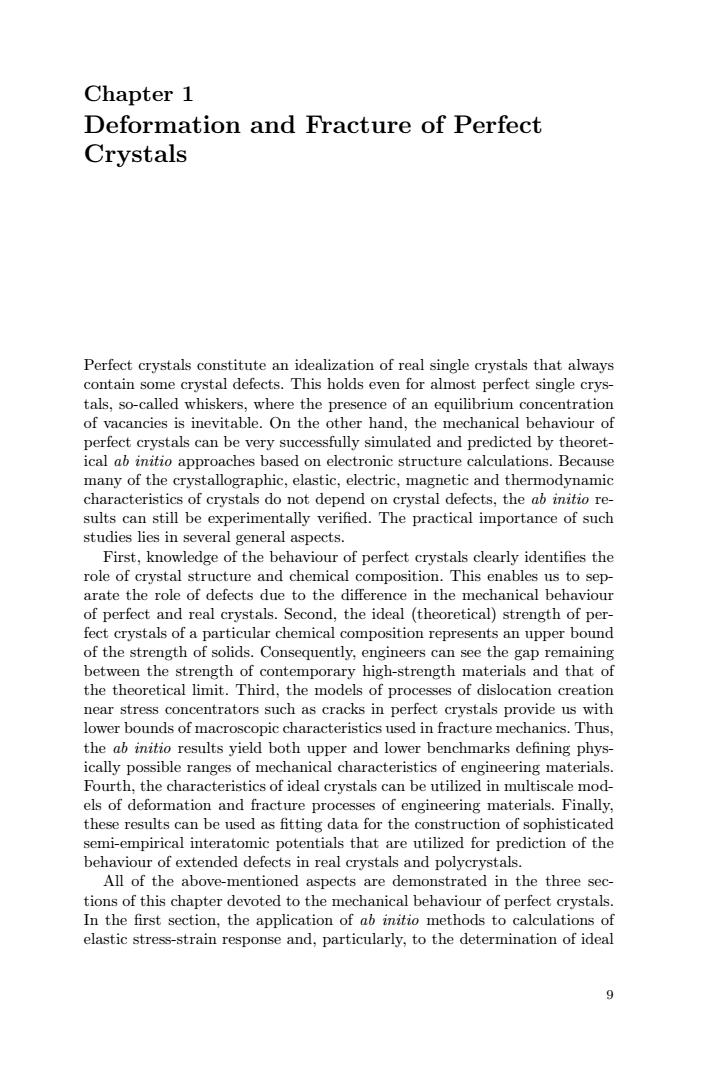正在加载图片...

Chapter 1 Deformation and Fracture of Perfect Crystals Perfect crystals constitute an idealization of real single crystals that always contain some crystal defects.This holds even for almost perfect single crys- tals,so-called whiskers,where the presence of an equilibrium concentration of vacancies is inevitable.On the other hand,the mechanical behaviour of perfect crystals can be very successfully simulated and predicted by theoret- ical ab initio approaches based on electronic structure calculations.Because many of the crystallographic,elastic,electric,magnetic and thermodynamic characteristics of crystals do not depend on crystal defects,the ab initio re- sults can still be experimentally verified.The practical importance of such studies lies in several general aspects. First,knowledge of the behaviour of perfect crystals clearly identifies the role of crystal structure and chemical composition.This enables us to sep- arate the role of defects due to the difference in the mechanical behaviour of perfect and real crystals.Second,the ideal (theoretical)strength of per- fect crystals of a particular chemical composition represents an upper bound of the strength of solids.Consequently,engineers can see the gap remaining between the strength of contemporary high-strength materials and that of the theoretical limit.Third,the models of processes of dislocation creation near stress concentrators such as cracks in perfect crystals provide us with lower bounds of macroscopic characteristics used in fracture mechanics.Thus, the ab initio results yield both upper and lower benchmarks defining phys- ically possible ranges of mechanical characteristics of engineering materials. Fourth,the characteristics of ideal crystals can be utilized in multiscale mod- els of deformation and fracture processes of engineering materials.Finally, these results can be used as fitting data for the construction of sophisticated semi-empirical interatomic potentials that are utilized for prediction of the behaviour of extended defects in real crystals and polycrystals. All of the above-mentioned aspects are demonstrated in the three sec- tions of this chapter devoted to the mechanical behaviour of perfect crystals In the first section,the application of ab initio methods to calculations of elastic stress-strain response and,particularly,to the determination of ideal 9Chapter 1 Deformation and Fracture of Perfect Crystals Perfect crystals constitute an idealization of real single crystals that always contain some crystal defects. This holds even for almost perfect single crystals, so-called whiskers, where the presence of an equilibrium concentration of vacancies is inevitable. On the other hand, the mechanical behaviour of perfect crystals can be very successfully simulated and predicted by theoretical ab initio approaches based on electronic structure calculations. Because many of the crystallographic, elastic, electric, magnetic and thermodynamic characteristics of crystals do not depend on crystal defects, the ab initio results can still be experimentally verified. The practical importance of such studies lies in several general aspects. First, knowledge of the behaviour of perfect crystals clearly identifies the role of crystal structure and chemical composition. This enables us to separate the role of defects due to the difference in the mechanical behaviour of perfect and real crystals. Second, the ideal (theoretical) strength of perfect crystals of a particular chemical composition represents an upper bound of the strength of solids. Consequently, engineers can see the gap remaining between the strength of contemporary high-strength materials and that of the theoretical limit. Third, the models of processes of dislocation creation near stress concentrators such as cracks in perfect crystals provide us with lower bounds of macroscopic characteristics used in fracture mechanics. Thus, the ab initio results yield both upper and lower benchmarks defining physically possible ranges of mechanical characteristics of engineering materials. Fourth, the characteristics of ideal crystals can be utilized in multiscale models of deformation and fracture processes of engineering materials. Finally, these results can be used as fitting data for the construction of sophisticated semi-empirical interatomic potentials that are utilized for prediction of the behaviour of extended defects in real crystals and polycrystals. All of the above-mentioned aspects are demonstrated in the three sections of this chapter devoted to the mechanical behaviour of perfect crystals. In the first section, the application of ab initio methods to calculations of elastic stress-strain response and, particularly, to the determination of ideal 9